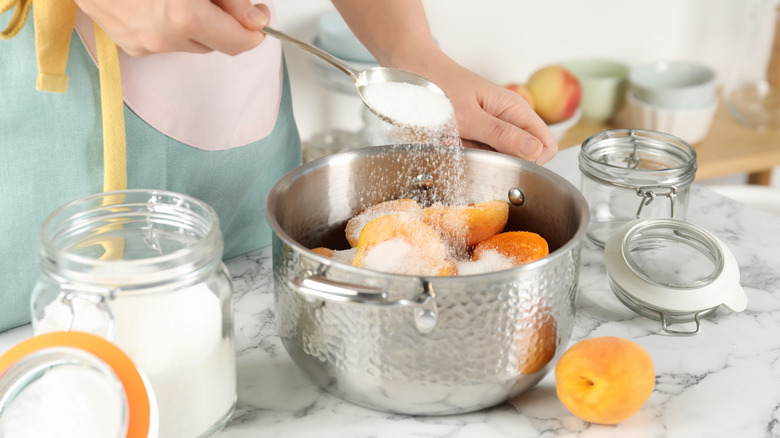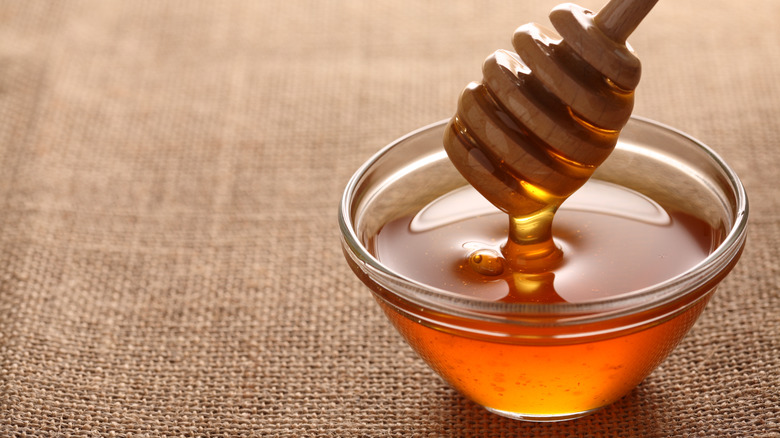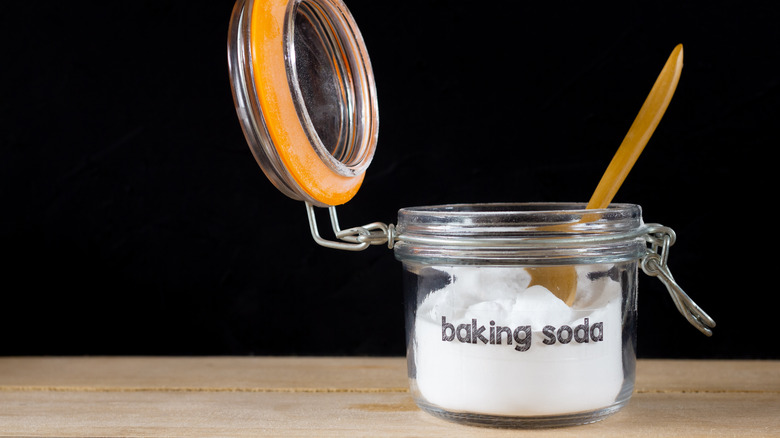The Simple Fix For Overly Sour Dishes Is Already In Your Pantry
Have you ever taken a first bite into a homemade dish, only to wince as what you thought you prepared following the recipe's exact instructions is bursting with sour flavors? Acidic ingredients, such as lemons, tomatoes, and vinegar, are common in recipes, so if you've ever experienced this, know that you are not alone. The quick fix to correct an overly sour dish lies in the shadows of your kitchen pantry. Simply adding a sweet ingredient, such as sugar or honey, will do the trick.
Think for a second about the basics of taste. Sweet is opposite sour, so to correct an overly sour dish, counterbalance the sourness with a little sweetness. (A popular Chinese restaurant classic, sweet and sour sauce, comes to mind.) This method works for some but not all dishes. Sugar could render the dish too sweet, while honey imparts not only sweetness but a honey flavor.
For highly acidic dishes, such as tomato-based sauces or gazpachos, a dash of baking soda is all you need. This alkalizes the acidity and neutralizes the flavor palate so you can build on that without the wince. But you have to be careful — adding too much baking soda will eviscerate the tomato taste, and you'll have to add copious amounts of salt to bring back faint remnants of what was once the flavor of tomato. So, use it sparingly, and be sure to taste as you go to course-correct as needed.
When to use sugar
Sugar is a great choice for combating the puckering mouthfeel of sourness. Adding sugar works best when there is a pronounced flavor in a dish (think lime in key lime pie) and you need to showcase that ingredient but encourage it to play nice with the others. Homemade dressings and those used to dress homemade macaroni salads usually benefit from the addition of sugar, but not always. Many American macaroni salad recipes call for the addition of a ½ teaspoon of sugar in the dressing, and you'll find that Amish-style macaroni salad adds sugar to the dressing as well.
Furthermore, if the dish has sweeter tones versus savory, sugar tends to work well to reduce any residual sourness. It can easily be incorporated into the sweetness of the existing flavors and does not impart any additional flavor (unless, of course, you use a flavored sugar, such as lavender sugar). Keep in mind, however, that granulated sugar has a coarse texture until it dissolves. It also adds texture when combined with certain ingredients, so you'll want to save its use for dishes that involve heat, unless the addition of a granular texture won't effect the end-result.
Alternatively, you can use powdered sugar, but keep in mind that it is slightly sweeter. It's recommended to use this substitute in baking for items that are smooth and creamy, such as icings and meringues.
When to use honey
Honey is a natural sweetener in liquid form, which makes it versatile to use in vinaigrettes. Dijon vinaigrette, for example, tends to call for the addition of honey to cut the sourness of the vinegar and mustard.
Because honey is a liquid sweetener, it can easily be whisked in to counterbalance any sour notes and maintain the same consistency. Or, take this homemade barbecue sauce recipe, which calls for three tablespoons of honey. The addition of the honey counterbalances the sour ingredients, including apple cider vinegar and Worcestershire sauce. Another great use of honey is with soy glazes and marinades as the sweetness of the honey tends to compliment the brininess of the soy. This soy-glazed Brussels sprouts with bacon recipe calls for 2 tablespoons of honey to be mixed in with the other wet ingredients to create the glaze.
As a general rule of thumb, honey is a sweeter alternative to sugar and can be added to more savory sauce-type recipes that call for a counterbalance of acidic tastes. It's also a great sugar substitute for individuals who need to monitor blood glucose levels. Alternatives to using honey to correct an overly sour dish are maple syrup, agave syrup, molasses, and corn syrup. These alternates, however, will change the flavor profile, so be sure that the flavors will work well together. If not, choose another sweet ingredient.
Use baking soda to alkalize sour dishes
Hiding somewhere in the depths of your pantry or the back of your refrigerator is a box of baking soda, just waiting for your use. A common ingredient found in baking, baking soda doubles as a useful culinary tool elsewhere, including to bring sour dishes back to a more palatable homeostasis.
The reason is simple chemistry. Baking soda is a chemical called sodium bicarbonate, and when combined with an acid, it releases carbon dioxide, a gas which changes the pH level of the acidic ingredient to more alkaline. The acidity level of tomato-based sauces are commonly neutralized with the addition of baking soda, as the baking soda won't impart any additional flavor or texture to the dish. And that's not all.
Baking soda can be used for many a kitchen hack, including some unexpected ways to cook and clean with baking soda. Now that you know you've been underutilizing baking soda, extend the shelf-life of your next box beyond that of a pantry staple or a deodorizer for your fridge. Sugar, honey, and baking soda are all you need to transform any overly sour dish to one that melds its flavors well together. Try that the next time you're in a pickle.



